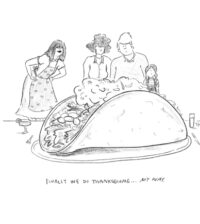Are we actually in danger of losing doctors in this community? Will Measure P bring them back?
Bill Hutchinson, co-chair of the Measure P Committee, introduced the question and the possible answer at the Sonoma Valley Chamber of Commerce “Election 08” Breakfast Forum on Sept. 12. “I think the issues are real,” he said, before introducing Carl Gerlach, CEO of the Sonoma Valley Hospital, to explain the hospital’s plan to address them.
Gerlach stepped up without a joke. “I thought I’d try to lighten up a bit,” he told the audience, “and went to Google to try to find some jokes relevant and funny about health care.” Knives and forks ceased clinking and people looked up. “Zero hits,” he said, to a ripple of knowing laughter. “It’s not funny,” he said. “It’s a mess! I look at Measure P as an opportunity of this community to take back some control on health care.”
Without allowing time for a possibly bond-weary audience to have their eyes glaze over, he posed a crucial question. “How many of you believe you really understand the hospital issue?” A smattering of hands fluttered up. “Now, how many of you personally – or a family member – used the hospital in the last couple of years?” About twice as many hands rose up. “Bingo,” he said. “Bingo.”
The purpose of Measure P, Gerlach explained, is to do what all the formal and informal surveys show that people want and need – it will keep the Emergency Room open.
Gerlach gave what he called a “Mach 3 fly-by” of the plan, describing how Measure P, a 20-year, $35-million general obligation bond, will preserve the emergency services and ongoing functioning of the hospital by addressing three things: upgrades, confidence and cash flow. “This is a good investment,” he said. “It’s a good deal.”
Taking the three aspects one by one, Gerlach first explained that due to the state’s rolling back some of the requirements, they would be able to upgrade on site. That means they could use the central wing until 2020, the west wing until 2030, and the east wing indefinitely. The site as a whole, he said, in a valley where land is at a premium, becomes useful indefinitely. He said that in dealing with medical groups, one of the hospital’s “trump cards” is the fact that it has land in Sonoma Valley. “We need to be able to play that trump card. We need to upgrade the facility.” As to what will be upgraded, he said that currently, running the old boilers and chillers and simply keeping up maintenance is extraordinarily expensive. He extended an open invitation to those interested to tour the facility and see for themselves.
The second thing Gerlach says the bond measure will do is reinstate confidence among prospective physicians. “After Measure C, we lost 35 percent of our in-patient surgical volume,” he said. “Bam. Out the door.” His mission was to get that back through a whole series of initiatives. When Measure F failed, all those initiatives stopped. Efforts to recruit doctors ground to a halt. Now, with the hope of this new bond measure, those initiatives and others have all been reborn.
“I will tell you that potential business partners are now lined up, and will come here – and it’s all about, ‘Will the bond measure pass?’” If it does not all those deals would collapse. “So,” he said, “that issue is critical.
The third effect of the bond measure that Gerlach anticipates is improving cash flow. By refinancing the current debt, he hopes will save the hospital about $1 million per year.
As for what the bond will cost the property-owner, Gerlach said the direct cost is very low. “It will be $14 per $100,000 of assessed value. The majority of taxpayers will pay less than $40 per year. And 75 percent of the taxpayers will pay less than $70 per year.” Gerlach contrasted this against the cost of hospital closure which, he said, “would be extreme and egregious.”
At the end of his presentation, arms shot up for questions. “Does this include any land? Any new buildings?” one questioner asked.
“No,” said Gerlach. “No new land. No new buildings.” He said they will be building a sort of box into which the boilers and chillers and utility systems go – which now, he said, is buried in the middle of the central wing.
“Will the hospital be closed during any of this?” asked another.
“No,” said Gerlach. “The strategy was to be able to stage and always to be able to have somewhere to go and not have to shut anything down. So there’s not going to be any closure of services.”
Another questioner asked whether, should the bond measure pass, there would be a need for a new hospital in the future. Gerlach responded that there would be a need eventually. “But in twenty years, can any of you imagine what a new hospital would look like?” he asked. “You can’t.” He described some of the advances in joint replacements and reduced in-patient time, as an example. “I heard yesterday that there was a knee replacement done in Marin General Hospital on an ambulatory basis.” He reminded the audience that despite changing hospital configuration, this hospital staff was “about as good as it gets.”
Back to the upgrades, Stanley Cohen asked Gerlach to describe what the retrofit would involve.
“We need to anchor everything,” Gerlach said. “There’s also in the budget the replacement of certain critical equipment. G.O. [general obligation]bonds can’t be used to purchase software, but they can be use to upgrade server rooms and cabling and switches for I.T. [information technology] So there’s more than just the heating and cooling and energy system. There’s a significant investment in medical technology, as well.”
Another questioner reminded Gerlach that in previous campaigns, the public had been led to believe that the hospital could not be built in place and that the entire facility needed to be replaced. Now, they are being asked to invest in that same facility. “How do you address that?” he asked.
Gerlach said that several things have changed. First, the state had changed its mandates, which has enabled the hospital to extend the use of the facilities. Second, the estimated number of needed beds has gone down, so additional land is not needed. Third, the “incredible” growth of the ambulatory work would indicate that the hospital would be better off spending money on the ambulatory side, instead of planning for additional beds. “You’ve got to just keep your eye on the ball,” Gerlach said.
Will Pier, a restoration specialist with Sonoma Ecology Center, and candidate for District One Supervisor, asked Gerlach whether, in all the research for economical improvements, the hospital had considered solar panels.
Gerlach said they had done an energy audit, and they could get about $2 million in California Energy Commission low interest loans. They didn’t look at solar panels, he said, because they were only dealing what they call the demand side of energy, or using energy. They didn’t look at the supply side, where they’d be generating their own energy.
Sonoma Valley Chamber of Commerce Executive Director Jennifer Yankovich, who had announced earlier that the chamber of commerce had endorsed Measure P, thanked Gerlach for his talk and restated his answer to a question that may have lingered in some minds. “The big thing is the state changed the rules,” she said. “We used to not be able to do the retrofit on site. Now we can.”
Bob Rice, communications director for the hospital, said the whole point of the bond measure is “to make sure that we’ve done what we can to protect what we have and make sure the hospital doesn’t close,” said Rice. “For dangerous financial times, this seems to be conservative and rational and it makes sense to people.”
Chamber of Commerce endorses Measure P hospital campaign
More from What's HappeningMore posts in What's Happening »
- Cartoon by Hillary: “Finally We Do Thanksgiving…My Way”
- Permit Sonoma Recommends Decertification of the SDC Specific Plan Environmental Report and Abandoning the SDC Specific Plan
- Chinook Salmon Spotted in Valley Creeks
- Lighted Tractor Parade Set for November 30 on Sonoma Plaza
- Creative Sonoma Announces #TeachTheArts Campaign to Boost Local Teaching Workforce
- The Living Legacy of Mac McQuown






